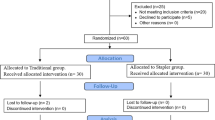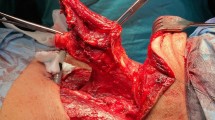Abstract
Closure of the pharyngeal defect after total laryngectomy had been traditionally performed with manual suturing techniques that invert the mucosal edge this technique though effective, yet it is time-consuming. Recently the use of stapling devices to successfully close the pharyngeal defect after total laryngectomy has been advocated to shorten the operative time, especially in the high-risk cancer patients where a prolonged operative time is not preferred. The present study aimed at comparing stapler assisted total laryngectomy to suture closure total laryngectomy in a prospective randomized manner. This is a prospective clinical study conducted on 60 patients undergoing total laryngectomy at Alexandria Main University Hospital, Egypt. Patients with tumor extension to the hypopharynx or base of the tongue were excluded from the study. The surgical time is reduced with shorter hospital stays and no increase in postoperative complications rate. The use of the stapler is technically easy to perform and as equally as effective as the traditional neopharyngeal suturing techniques in patients undergoing total laryngectomy.





Similar content being viewed by others
References
Benson EM, Hirata RM, Thompson CB, Ha PK, Fakhry C, Saunders JR et al (2015) Pharyngocutaneous fistula after total laryngectomy: a single-institution experience, 2001–2012. Am J Otolaryngol 36(1):24–31
Dedivitis RA, Aires FT, Pfuetzenreiter EG Jr, Castro MA, Guimaraes AV (2014) Stapler suture of the pharynx after total laryngectomy. Acta Otorhinolaryngol Ital 34(2):94–98
Zhang X, Liu Z, Li Q, Liu X, Li H, Liu W et al (2013) Using a linear stapler for pharyngeal closure in total laryngectomy. Eur Arch Otorhinolaryngol 270(4):1467–1471
Bedrin L, Ginsburg G, Horowitz Z, Talmi YP (2005) 25-year experience of using a linear stapler in laryngectomy. Head Neck 27(12):1073–1079
Wada AM, Hashiba K, Otoch JP, Brasil H, Marson FP, Cassab J et al (2018) Full-thickness endoscopic gastric resection using a stapler and gastrostomy: a feasibility study. Arquivos Brasileiros de Cirurgia Digestive 31(3):e1386
Galletti BFF, Catalano N, Nicita RA, Bruno R, Galletti C, Galletti F (2018) Linear stapler closure of the pharynx in laryngectomy: our experience (endoscopic closed technique). J Vis Surg 4:228–234
Bampoe S, De Silva S, Scott M (2015) Magnetic resonance imaging safety of surgical clips and staples. Anaesthesia 70(12):1463
Gayton JC, Sensiba P, Imbrogno BF, Venkatarayappa I, Tsatalis J, Prayson MJ (2011) The effects of magnetic resonance imaging on surgical staples: an experimental analysis. J Trauma 70(5):1279–1281
Aires FT, Dedivitis RA, Castro MA, Bernardo WM, Cernea CR, Brandao LG (2014) Efficacy of stapler pharyngeal closure after total laryngectomy: a systematic review. Head Neck 36(5):739–742
Miles BA, Larrison D, Myers LL (2013) Comparison of complication rates associated with stapling and traditional suture closure after total laryngectomy for advanced cancer. Ear Nose Throat J 92(8):392–399
Haksever M, Akduman D, Aslan S, Solmaz F, Ozmen S (2015) Modified continuous mucosal connell suture for the pharyngeal closure after total laryngectomy: zipper suture. Clin Exp Otorhinolaryngol 8(3):281–288
Liang G, Fu W, Wang K (2019) Analysis of t-test misuses and SPSS operations in medical research papers. Burns Trauma 7:31
Ugoni A, Walker BF (1995) The Chi square test: an introduction. COMSIG Rev 4(3):61–64
Kim HY (2019) Statistical notes for clinical researchers: the independent samples t-test. Restor Dent Endod 44(3):e26
Tomifuji M, Araki K, Kamide D, Tanaka S, Tanaka Y, Fukumori T et al (2014) Total laryngectomy using a linear stapler for laryngeal cancer. Nihon Jibiinkoka Gakkai kaiho 117(6):821–826
Ozturk K, Turhal G, Ozturk A, Kaya I, Akyildiz S, Uluoz U (2019) The Comparative analysis of suture versus linear stapler pharyngeal closure in total laryngectomy: a prospective randomized study. Turkish Archiv Otorhinolaryngol 57(4):166–170
Hoehn JG, Payne WS (1969) Resection of pharyngoesophageal diverticulum using stapling device. Mayo Clin Proc 44(10):738–741
Shan H, Gao Y, Liu L, Li M, Gao X, Li Y et al (2018) Magnifying endoscopy with narrow-band imaging to assist the linear stapler closure of the pharynx during total laryngectomy. Am J Otolaryngol 39(5):511–514
Agrawal A, Schuller DE (2000) Closed laryngectomy using the automatic linear stapling device. Laryngoscope 110(8):1402–1405
Calli C, Pinar E, Oncel S (2011) Pharyngocutaneous fistula after total laryngectomy: less common with mechanical stapler closure. Ann Otol Rhinol Laryngol 120(5):339–344
Parikh SR, Irish JC, Curran AJ, Gullane PJ, Brown DH, Rotstein LE (1998) Pharyngocutaneous fistulae in laryngectomy patients: the Toronto Hospital experience. J Otolaryngol 27(3):136–140
Patel UA, Moore BA, Wax M, Rosenthal E, Sweeny L, Militsakh ON et al (2013) Impact of pharyngeal closure technique on fistula after salvage laryngectomy. JAMA 139(11):1156–1162
Backemar L, Wikman A, Djarv T, Johar A, Lagergren P (2016) Co-morbidity after oesophageal cancer surgery and recovery of health-related quality of life. Br J Surg 103(12):1665–1675
Backemar L, Lagergren P, Johar A, Lagergren J (2015) Impact of co-morbidity on mortality after oesophageal cancer surgery. Br J Surg 102(9):1097–1105
Cecatto SB, Soares MM, Henriques T, Monteiro E, Moura CI (2014) Predictive factors for the postlaryngectomy pharyngocutaneous fistula development: systematic review. Brazil J Otorhinolaryngol 80(2):167–177
Zhang X, Cavus O, Zhou Y, Dusitkasem S (2018) Airway Management during anesthetic induction of secondary laryngectomy for recurrent laryngeal cancer: three cases of report and analysis. Front Med 5:264
Mastropietro C (1987) The anesthetic considerations for the patient undergoing total laryngectomy. AANA J 55(3):237–244
Sofferman RA, Voronetsky I (2000) Use of the linear stapler for pharyngoesophageal closure after total laryngectomy. Laryngoscope 110(8):1406–1409
Altissimi G, Frenguelli A (2007) Linear stapler closure of the pharynx during total laryngectomy: a 15-year experience (from closed technique to semi-closed technique). Acta Otorhinolaryngol Ital 27(3):118–122
Kral V, Neoral C, Aujesky R (1995) Advantages and disadvantages of cervical esophageal anastomosis using a stapler. Rozhl Chir 74(8):439–441
Santaolalla Montoya F, Ruiz de Galarreta JC, Sanchez del Rey A, Martinez Ibarguen A, Zabala Lopez de Maturana A (2002) Comparative study of the use of manual and mechanical suturing in the closure of the mucosal defect in total laryngectomy. Acta Otorrinolaringologica Espanola 53(5):343–50
Acknowledgement
The authors would like to extend our thanks to Dr. Mohamed Zahran, M.D., and Dr. Enas Alyaldin who shared in the data collection.
Author information
Authors and Affiliations
Corresponding author
Ethics declarations
Conflict of interest
Author Omar Ahmed declares that he has no conflict of interest. Author Hesham Mustafa Abdel-Fattah declares that he has no conflict of interest. Author Hisham E.M. Elbadan, M.D, declares that he has no conflict of interest.
Human and Animal Rights
All procedures performed in this study involving human participants were in accordance with the ethical standards of the institutional research committee and with the 1964 Helsinki declaration and its later amendments.
Informed Consent
Informed consent was obtained from all individual participants included in the study.
Additional information
Publisher's Note
Springer Nature remains neutral with regard to jurisdictional claims in published maps and institutional affiliations.
Rights and permissions
About this article
Cite this article
Ahmed, O., Abdel-Fattah, H.M. & Elbadan, H.E.M. Stapler Assisted Total Laryngectomy: A Prospective Randomized Clinical Study. Indian J Otolaryngol Head Neck Surg 74 (Suppl 2), 2205–2213 (2022). https://doi.org/10.1007/s12070-020-02086-3
Received:
Accepted:
Published:
Issue Date:
DOI: https://doi.org/10.1007/s12070-020-02086-3




